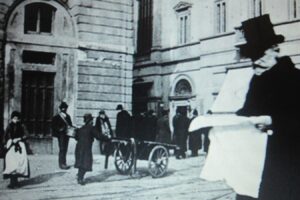

“Oh, ha, ha, there is no better example of the absurdity of opera than to think the poor silly tart should die of dehydration in this mysterious sandy wasteland unknown to cartographers of the Bayou State, serves her right for not knowing there aren’t any deserts in Louisiana, and but who cares with all those lovely Puccini tunes,” your average full-of-himself queen will titter at one point or another, though probably not in quite so prolix a fashion.
Look, La Cieca was born in Louisiana and lived some years in New Orleans, so she knows the terrain reasonably well. There is plenty of undeveloped land not too far from New Orleans even now, and in the 1730s you probably could get lost in the countryside as little as an hour’s walk from the French Quarter.
The scene description in the libretto of Manon Lescaut says “Una landa sterminata sui confini del territorio della Nuova Orléans. Terreno brullo ed ondulato; orizzonte vastissimo; cielo annuvolato.” That is, a bleak, uneven landscape: to an Italian, that might mean an actual desert, or it might just as well mean a prairie or a steppe.
In fact, only Manon actually calls the place “deserto,” and even she in her delirium has enough sense to realize that she is not hallucinating Monument Valley but rather poetically describing a desolate or barren place.
And that is consistent with the source material. According to Prévost’s novel, Manon and Des Grieux have not long after their arrival in New Orleans run in to yet more trouble, so they decide to leave town, hoping for for shelter among “des Anglais qui ont, comme nous, des établissements dans cette partie du Nouveau Monde.” So they are off to… Georgia, perhaps, or the Carolinas, but at any rate east.
They don’t get far, though:
Nous marchâmes aussi longtemps que le courage de Manon put la soutenir, c’est-à-dire environ deux lieues, car cette amante incomparable refusa constamment de s’arrêter plus tôt. Accablée enfin de lassitude, elle me confessa qu’il lui était impossible d’avancer davantage. Il était déjà nuit. Nous nous assîmes au milieu d’une vaste plaine, sans avoir pu trouver un arbre pour nous mettre à couvert.
A “lieue” was about two miles, so Manon and Des Grieux might have covered four miles by nightfall. Now, four miles east of the French Quarter in those days would have landed you in the middle of nowhere, say around where the Lower Ninth Ward or Gentilly are today. It’s not farm land, so nobody would be living there back then, and even the heart-rending absence of “un arbre pour nous mettre à couvert” so near the Mississippi River we may chalk up to the fact that the author’s description is meant to be poetic, not strictly littoral.
So Leoncavallo, Praga, Giacosa, Oliva and Illica and Ricordi weren’t so silly after all: at least, unlike Meilhac and Gille, they killed off the heroine on the proper continent!

























Comments